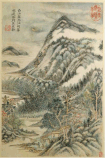Four Wangs
Appearance
Wang Shimin,Landscapes Inspired by Du Fu's Poetry
Painting of Wang Jian
Wang Hui,Fisherman Huts and Clearing Skies in Autumn
Wang Yuanqi,Mountain Dwelling on a Summer Day
TheFour Wangs(Chinese:Tứ vương;pinyin:Sì Wáng;Wade–Giles:Ssŭ Wang) were fourChineselandscapepainters during theQing dynastyin the 17th century, all with the surnameWang.They are best known for their accomplishments inshan shuipainting.
The painters
[edit]They wereWang Shimin(1592–1680),Wang Jian(1598–1677),Wang Hui(1632–1717) andWang Yuanqi(1642–1715).[1]They were members of the group known as theSix Masters of the early Qing period.[1]
Philosophy
[edit]The Four Wangs represented the so-called "orthodox school" of painting at the time. The school was based on the teachings ofDong Qichang(1555–1636). It was “orthodox” in the Confucian sense that it had continuing traditional modes, as they were in contrast to the "Individualist" painters such asBada ShanrenandShitao.[2]
See also
[edit]References
[edit]- ^abCihai: Ci hai bian ji wei yuan hui ( từ hải biên tập ủy viên hội ). Ci hai ( từ hải ). Shanghai: Shanghai ci shu chu ban she ( thượng hải từ thư xuất bản xã ), 1979 Page 757.
- ^"Four Wangs | Chinese Painting | China Online Museum".www.chinaonlinemuseum.com.Retrieved2019-12-23.
Further reading
[edit]- Fong, Wen C.; et al. (2008).Landscapes clear and radiant: the art of Wang Hui (1632-1717).New York: The Metropolitan Museum of Art.ISBN9781588392916.
External links
[edit]- Four Wangs' Painting Galleriesat China Online Museum




